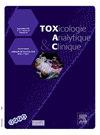扩展死后毒理学工具箱:玻璃体幽默代谢组学的焦点
IF 1.7
Q4 TOXICOLOGY
引用次数: 0
摘要
目的:为死后玻璃体幽默的非靶向代谢和脂质组学分析开发量身定制的样品制备方案,并探索其代谢组学景观用于法医应用。传统的死后毒理学主要关注中毒,严重依赖于外源性药物的测量及其随后的解释。然而,为了解决更广泛的法医调查,在毒理学调查中需要一种额外的分析方法。死亡代谢组学是对死后生物体液中的小内源性代谢物(如脂质、氨基酸)进行系统分析的一种新兴概念,旨在解决关键挑战,如准确确定死后时间间隔和阐明死亡前的生化事件。虽然血液仍然是传统法医毒理学的金标准,但它有明显的局限性,包括微生物降解和死后化合物的重新分配,这引入了依赖于采样条件的可变性。玻璃体体液是一种代谢更稳定的死后生物体液,为死亡代谢组学研究提供了一种有前途的替代基质。然而,对文献的全面回顾表明,缺乏针对玻璃体幽默的非靶向代谢组学分析的既定方案,阻碍了死后毒理学领域的进步。方法对建立的3种样品制备工艺:Folch双相萃取(CHCl3: MeOH: H2O, 8:4:3, v/v/v)、Bligh-Dyer双相萃取(CHCl3: MeOH: H2O, 2:2:1.8, v/v/v)和甲醇单相萃取的3种稀释系列进行评价。此外,通过重新提取剩余的蛋白质残留物来评估每种样品制备中的代谢物回收率。然后使用四个内部代谢组学平台进行数据采集,采用液相色谱法耦合四极杆飞行时间高分辨率质谱法。最后用MS-DIAL软件对数据进行预处理。结果本研究结果表明,玻璃体中低浓度的脂质需要大样本量,而极性代谢物则以较高的浓度存在,允许更小的样本量。鉴定出多种代谢物,主要与能量代谢(如有机酸、肉毒碱)、氨基酸代谢(如色氨酸、赖氨酸、酪氨酸)、氧化应激调节(如蛋氨酸、谷胱甘肽)和核苷酸代谢(如次黄嘌呤、胞苷、尿苷)的途径相关。脂质部分主要由磷脂、脂肪酸和鞘磷脂组成,支持诸如能量产生、细胞间通讯和维持结构完整性等关键功能。Folch萃取法和Bligh-Dyer萃取法都被证明优于单相萃取法,Bligh-Dyer萃取法特别增强了正电离模式下脂质的检测。此外,与单相萃取相比,Folch和Bligh-Dyer萃取在正电离和负电离模式下都显示出更多样化的脂质谱。除了单相提取中的脂质外,再提取对极性代谢物和双相提取中的脂质都没有额外的益处。死后玻璃体体液代谢组学数据的解释仍然具有挑战性,因为先前的研究范围有限,并且缺乏分析前样品处理的标准化方案和指南。关键的分析前因素,如短期和长期稳定性以及不同收集容器的影响,仍未得到探讨,使这些初步结论的评价复杂化。结论本研究表明,双相提取对于有效检测玻璃体体液中稀疏的脂质含量至关重要,为进一步的法医应用提供了玻璃体体液的全面分析。然而,在死后玻璃体幽默中可以检测到多种代谢物和脂质,强调了其作为死后调查有价值的替代基质的潜力。然而,对于死后玻璃体体液代谢组学和脂质组学数据的深入评估,需要对分析前因素进行标准化和进一步调查。本文章由计算机程序翻译,如有差异,请以英文原文为准。
Expanding the post-mortem toxicological toolbox: A focus on vitreous humour metabolomics
Aim
Development of a tailored sample preparation protocol for untargeted metabolic and lipidomic profiling of post-mortem vitreous humour, and exploration of its metabolomic landscape for forensic applications.
Introduction
Traditional post-mortem toxicology primarily focuses on intoxications and relies heavily on the measurement of xenobiotics and their subsequent interpretation. However, to resolve broader forensic inquiries, an additional analytical approach is needed in toxicological investigations. Thanatometabolomics, the systematic analysis of small endogenous metabolites (e.g. lipids, amino acids) in post-mortem biofluids, represents an emerging concept aimed at addressing critical challenges, such as accurately determining the post-mortem interval and elucidating biochemical events preceding death. Although blood remains the gold standard in traditional forensic toxicology, it has notable limitations, including microbial degradation and post-mortem redistribution of compounds, which introduces variability dependent on sampling conditions. Vitreous humour, a more metabolite-stable post-mortem biofluid, offers a promising alternative matrix for thanatometabolomic research. However, a thorough review of the literature reveals a significant lack of established protocols for untargeted metabolomic analysis of vitreous humour, hindering progress in advancing the field of post-mortem toxicology.
Method
Three dilution series derived from three established sample preparation procedures: Folch biphasic extraction (CHCl3: MeOH: H2O, 8: 4: 3, v/v/v), Bligh-Dyer biphasic extraction (CHCl3: MeOH: H2O, 2: 2: 1.8, v/v/v) and a methanol single-phase extraction were evaluated. Additionally, the metabolite recoveries in each sample preparation were assessed through re-extraction of the remaining protein residue. Data acquisition was then performed with four in-house metabolomic platforms, employing liquid chromatography coupled to Quadrupole-Time of Flight high-resolution mass spectrometry. Finally, data preprocessing was conducted with MS-DIAL.
Results
The results of this study showed that low concentrations of lipids in vitreous humour necessitate large sample volumes, while polar metabolites are present in higher concentrations, allowing for smaller sample volumes. A diverse array of metabolites was identified, predominantly associated with pathways involved in energy metabolism (e.g. organic acids, carnitine), amino acid metabolism (e.g. tryptophan, lysine, tyrosine), oxidative stress regulation (e.g. methionine, glutathione), and nucleotide metabolism (e.g. hypoxanthine, cytidine, uridine). The lipid fraction was primarily composed of phospholipids, fatty acids, and sphingomyelins, supporting key functions such as energy production, intercellular communication, and the maintenance of structural integrity. Both, Folch and Bligh-Dyer extractions, proved superior to single-phase extraction, with Bligh Dyer particularly enhancing the detection of lipids in positive ionization mode. Additionally, Folch and Bligh-Dyer extraction revealed a more diverse array of lipid profiles compared to single phase extraction, in both positive and negative ionization modes. Re-extraction provided no additional benefit for either polar metabolites or lipids in the biphasic extractions, except for lipids in the single-phase extraction.
Discussion
The interpretation of post-mortem vitreous humour metabolomics data remains challenging due to the limited scope of prior research and the absence of standardized protocols and guidelines for pre-analytical sample handling. Critical pre-analytical factors, such as short-term and long-term stability and the influence of different collection containers, remain unexplored, complicating the evaluation of these preliminary findings.
Conclusion
The study demonstrates that biphasic extractions are essential for effectively detecting the sparse lipid content in vitreous humour, ensuring comprehensive profiling of vitreous humour for further forensic applications. Nevertheless, a diverse range of metabolites and lipids can be detected in post-mortem vitreous humour, underscoring its potential as a valuable alternative matrix for post-mortem investigations. However, standardization and further investigation regarding pre-analytical factors is required for in depth assessment of post-mortem vitreous humour metabolomic and lipidomic data.
求助全文
通过发布文献求助,成功后即可免费获取论文全文。
去求助

 求助内容:
求助内容: 应助结果提醒方式:
应助结果提醒方式:


